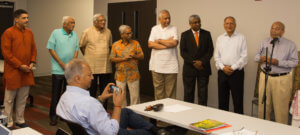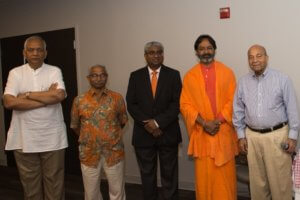Published by Sri Sivani Charan Yalamanchi on Feb 9, 2023 1:33:58 PM
This is a two-part essay that delves into the warfare rules of engagement, ethics and overall perspectives in ancient Bharat. The essay is part of the academic requirement for the HUA course ‘Reconstructing Hindu History – The Omissions’ taught by Dr. Raj Vedam. The first part of the essay briefly introduces different works on warfare, when war is justified, different types of war, and ethics and rules of war. The second part, to be published soon, will cover the army composition, its organizational structure, troops distribution, war strategy, and weaponry.

Warfare in Ancient Bharat: Part 1
Ancient Bharat had witnessed many wars in every yuga be it Satya (Krita) Yuga, Treta Yuga, Dwapara Yuga, and Kali Yuga. Some of the famous wars were the war of ten kings, the war between Rama and Ravana in the Treta Yuga, and the Kurukshetra war in the Dwapara Yuga. Besides, many other wars were mentioned in various Puranas and many other wars were recorded in history. If Bharat had witnessed many such wars besides modern ones, it implies that Bharat had a rich history of warfare, weapons, and martial arts which might have evolved to higher functionality from rudimentary levels. This paper is an attempt to summarize ancient Bharat’s warfare and weaponry.
Works on Warfare
Dhanurveda, one of the four upavedas and part of Yajurveda, deals with archery and military science. The other three upavedas are Ayurveda, Gandharvaveda, and Natyaveda, which are part of the Rig, Sama, and Atharvana Vedas respectively. The term ‘Dhanurveda’ usually denotes the artillery science. Dhanurveda mainly covers weapons and training, war ethics, war strategy, and army composition besides training horses, elephants, etc.
Moreover, Vasishta’s treatise on Dhanurveda, called Dhanurveda Samhita, and Nitiprakashika by Vaisampayana deal with the same. Agni Purana also deals with weapons. The Vishnu Purana mentions Dhanurveda as one of the eighteen traditional branches of knowledge. In addition to the mention of training horses and elephants in Dhanurveda, there are works like Asva Sastra, Asvacikitsa, Hastyayurveda, and Matangalila that explicitly deal with elephants and horses. Arthashastra by Kautilya was based on several earlier treatises, and teachers like Vishalaksha and Bharadwaja deal with politics, state administration, warfare, military strategies, other essential aspects of war, etc.
According to L. N. Rangarajan, the author of the book ‘Kautilya-The Arthashastra’, there were a minimum of four distinct schools of thought and thirteen individual teachers of Arthashastra before Kautilya. Other notable works that fall into the category of Arthashastra are Sukra Niti by Sukracharya, Kamandakiya Nitishastra, Harihara Caturanga, Sangrama-Vijayodaya, etc.
War and Types of War
In Sanatana Dharma, wars are fully justified as an integral part of dharma. War is completely acceptable if it is fought to uphold Dharma or to protect the weak and the innocent. According to Manu and Kautilya, wars were fought not only for self-defense against external aggression but also for the territory’s enlargement by conquest. Moreover, they explain that a king aims to destroy a natural enemy because if he does not eliminate the enemy, he will be eliminated by the enemy.
It can be widely seen that war was always used as a last resort after exhausting all the measures to maintain peace, which is evident from Ramayana, Mahabharata, and other such scriptures. The ancient Hindu society realized the importance of peace and hence followed a four-stage process to avoid war and settle disputes. These stages are:
- Sama – peaceful negotiation
- Dana – offering gifts appeasing the enemy
- Bheda – veiled threat
- Danda – use of force
According to ancient Hindu society, war was not just confined to physical war. War was classified into four kinds by Kautilya, who is also called Chanakya in Artha Sastra.
- Mantrayuddha – war by counsel employed by a weaker king when waging an open war is not a good idea
- Prakasayuddha – open war
- Kutayuddha – a concealed war that meant irregular warfare and psychological warfare, including the instigation of treachery in the enemy camp
- Gudayuddha – using covert methods to achieve the objective without waging a battle
In one of the strategies employed by the ancient Bharatiya kings that fall under Gudayuddha, gifts were sent to the invading kings, which also included the Poison Maiden (Visha Kanya) to kill the enemy king. In a letter (Latin – Elgood, Arabic translation by Al-Batriq) written by Aristotle to Alexander cautioning him about a Poison Maiden, he says “Remember what happened when the king of India sent three rich gifts and among them that beautiful maiden whom they had fed on poison until she was the nature of a snake.
Had I not perceived it because of my fear, for I feared the clever men of those countries and their craft, and had I not found by proof that she would be killing thee by her embrace and by her perspiration, she would surely have killed thee.”
Ethics and Rules of War in Ancient Bharat
During a war, Hindu kings abided by certain ethics which were mentioned in several ancient scriptures mentioned previously. Even accounts of Greek scholars mentioned that wars in Bharat were fought between kings and armies and no civilians were harmed in this process. Greek ambassador Megasthenes mentions, “Whereas among other nations it is usual in the contests of war to ravage the soil and thus reduce it to an uncultivated waste, among the Indians, on the contrary by whom husbandmen are regarded as a class that is sacred and inviolable, the tillers of the soil, even when in battle is raging in the neighborhood, are undisturbed by any sense of danger, for the combatants on either side in waging the conflict make carnage of each other, but allow these engaged in husbandry to remain unmolested.
Besides they neither ravage an enemy’s land with fire nor cut down its trees. Nor would an enemy coming upon a husbandman’s at work on land do him harm, for men of this class, being regarded as public benefactors, are protected from all injury”. This kind of war code was employed in the western world through the Geneva convention in 1949.
War Ethics and rules of engagement in the Mahabharata, Ramayana, Dhanurveda, and Vedas:
- The place and time of war must be specified beforehand to be in accordance with dharma.
- War is to begin at sunrise and end at sunset.
- A single warrior cannot be attacked by multiple warriors.
- When two warriors engage in a duel, they shouldn’t be intervened.
- A surrendered warrior should be unharmed.
- A surrendered warrior becomes a prisoner of war and is subject to the protections allocated to such a warrior.
- An unarmed warrior cannot be harmed.
- Anyone (human or animal) not involved in the war should be left unharmed.
- Unless considered a direct threat, animals in battle cannot be killed.
- A warrior involved in a battle with a weapon should abide by certain rules. For example, striking the enemy with a mace below the waist was forbidden.
- Warriors should not be engaged in an unjust war; it had to be a just war.
- Land should not be harmed in any form.
- Women, children, the sick, and farmers should not be affected in a battle and war prisoners were considered sacred.
- A warrior should not be struck from the back.
- Poisoned weapons and arrowheads were forbidden.
- Mass destruction weapons that wiped off the entire population were prohibited.
- An enemy who is lying unconscious, who is crippled, who does not have a weapon or is stricken with fear, and who came for asylum should not be killed.
- A strong and brave warrior should not chase and kill any fleeing enemy stricken with fear.
When a territory is acquired by conquest, the conqueror king shall:
- Be twice as good as the previous king.
- Follow policies that are pleasing and beneficial to the constituents by acting according to his dharma.
- Adopt the way of life, dress, language, and customs of the people of the acquired territory, show the same devotion to the gods of the territory as to his own gods and participate in the people’s festivals and amusements.
- Ensure the practice of all customs which are in accordance with dharma.
- Ensure that worship is held regularly in all the temples and ashrams.
- Grant land, money, and tax exemptions to the men distinguished for their learning, speech, dharma, or bravery.
- The ill, the helpless, and the distressed shall be helped.
When the enemy camp is raided, these people should not be attacked:
- Anyone falling in the fight.
- Those turning their backs.
- Anyone surrendering.
- Anyone who unties his hair as a symbol of surrender or throws his weapons down.
- Anyone contorted by fear.
- Anyone who does not fight.
Furthermore, Manu Smriti also has some battle rules:
- The conqueror has the obligation of treating the defeated ones with humanity.
- A warrior should not strike with weapons concealed nor with barbed, poisoned, or the points of which are blazing with fire.
- People walking on the road, travelers, or those who are engaged in eating and drinking or pursuing their activities and Brahmans should not be harmed unless engaged in a war.
- Combat between the mounted and the unmounted was prohibited.
- Combat between warriors of officer rank and foot soldiers was not allowed.
- Collective attacks against a single soldier and the slaying of a warrior who had a temporary disadvantage during the battle were strictly prohibited
Despite multiple treatises pointing out the act of using poisoned weapons as cowardly, Dhanurveda had techniques of Phalapayana, a technique to make arrows poisonous. One of the recorded instances where poisonous swords and arrows were used was in the battle between King Sambus and Alexander where Ptolemy, the Greek general of Alexander was wounded by a poisoned arrow. Moreover, many soldiers who were wounded by poisoned swords, and arrows died soon after.
References & Works Consulted
Chakravarti, P.C., The Art of War in Ancient India (General Printers & Publishers, 1941), University of Dacca. Accessed at https://archive.org/details/in.ernet.dli.2015.28200
Crindle, J.W.M., The Invasion of India by Alexander the Great, (Westminster Archibald Constable and Company, 1896). Accessed at https://archive.org/details/invasionindiaby00arrigoog/mode/2up
Hema Hari, D.K. and Hari, D.K., Autobiography of India: Breaking the Myths – About Identity (Sri Sri Publications Trust, 2018), accessed at https://www.amazon.com/Autobiography-India-Identity-Breaking-Myths-Vol1-About-ebook/dp/B07C15GJMG
Modi, Jivanji Jamshedji, Asiatic Papers, Part IV, (Times of India Press, 1929). Accessed at https://archive.org/details/in.ernet.dli.2015.30255.
Mookerji, Radha Kumud, Chandragupta Maurya and His Times, University of Madras, 1943. Accessed at https://archive.org/details/in.ernet.dli.2015.281321.
Ramachandra Dikshitar, V.R., War in Ancient India (Macmillan & Co., 1944), University of Madras. Accessed at https://archive.org/details/in.ernet.dli.2015.503472
Rangarajan, L.N., Kautilya, The Arthashastra (Penguin Books, 1992). Accessed at https://archive.org/details/kautaliya-arthshashtra-ancient-India/mode/2up
Ray, Purnima, Vasişţa’s Dhanurveda Samhitā (J.P. Publishing House, 2003). Accessed at https://archive.org/details/in.ernet.dli.2015.382701
Vittal, Vinay, “Kautilya’s Arthasastra: A timeless Grand strategy” (Graduate Thesis, Maxwell Air Force Base, AL. 2011). Accessed at https://apps.dtic.mil/sti/pdfs/AD1019423.pdf
Dhanurveda – Works on ancient Indian artilleries. Accessed at http://mahabharata-research.com/onewebmedia/chapter%203.pdf
Hinduwebsite, accessed at https://www.hinduwebsite.com/hinduism/h_war.asp
Hinduwebsite, accessed at https://www.hinduwebsite.com/ask/is-war-justified.asp
Sanskriti Magazine, accessed at https://www.sanskritimagazine.com/indian-religions/hinduism/hinduism-code-ethics-war/
Hindu Online, accessed at http://hinduonline.co/scriptures/dhanurveda/dhanurveda.html
Surya’s Tapestry, accessed at https://www.hinduwisdom.info/War_in_Ancient_India.html
We acknowledge the editorial assistance provided by Dr. Kalyani Samantray, Sri Sri University, Odisha, India.










